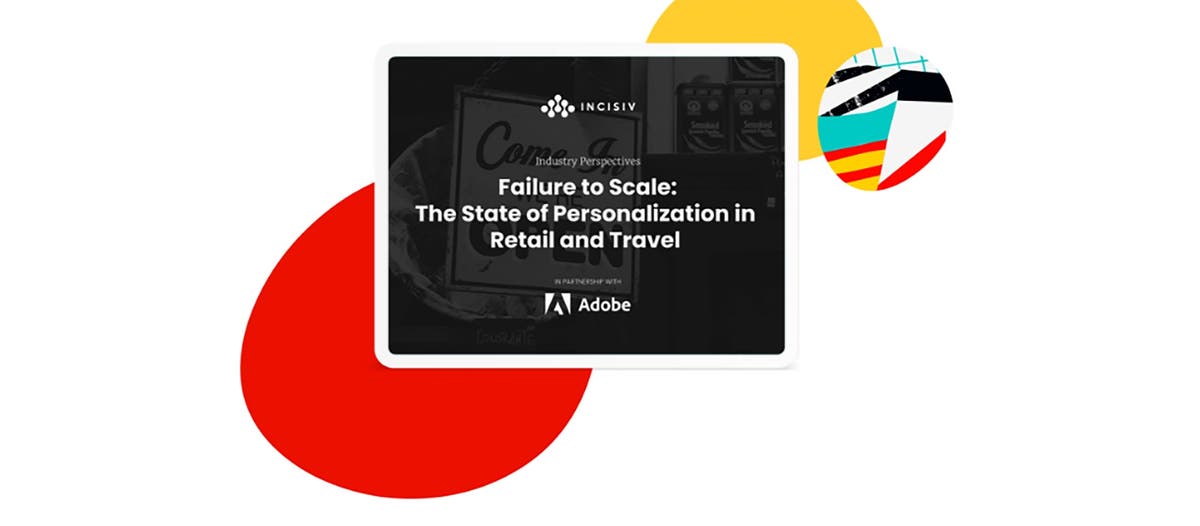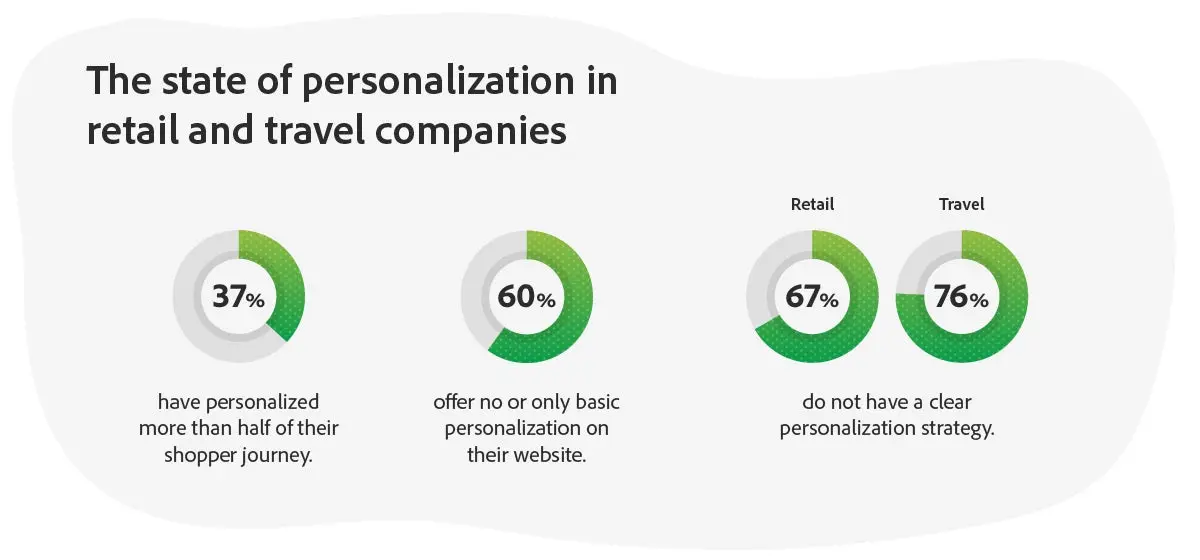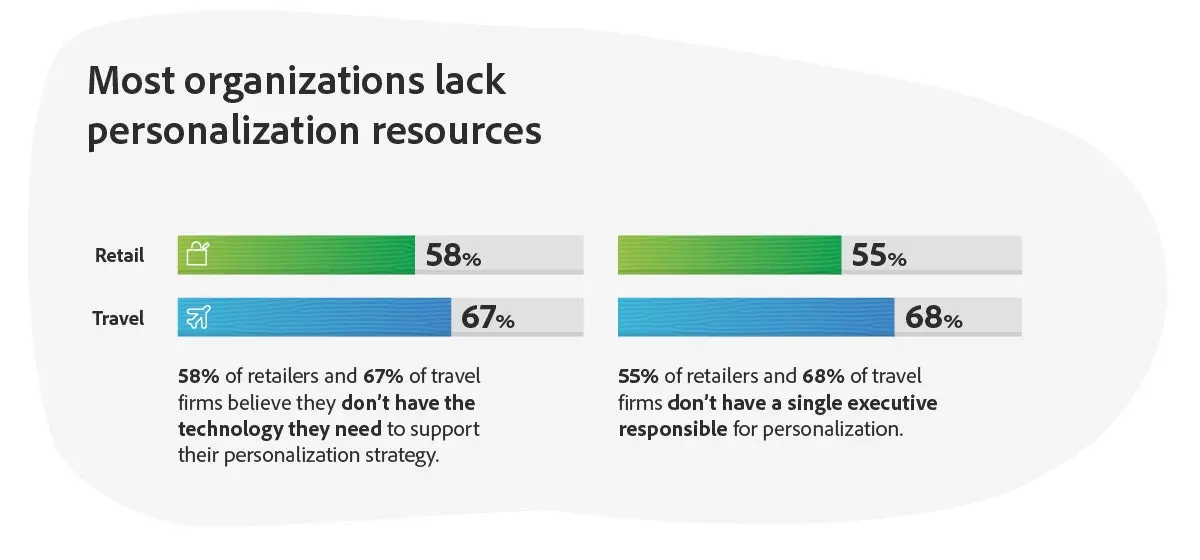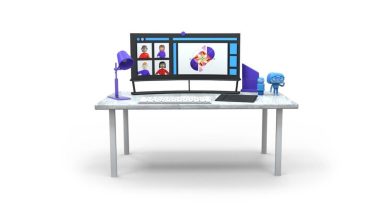Personalization in Retail

Today’s retail and travel organizations are switching gears from responding to the pandemic to planning for future growth. According to the April 2021 Adobe Digital Economy Index, global e-commerce is on pace to hit $4.2 trillion this year. Meanwhile, travel bookings for November and December 2021 are 30 percent higher than they were at this point in 2019, reflecting that consumers, despite lingering uncertainty, are more confident about future plans.
One growth strategy that marketing and technology leaders in both of these industries have embraced — at least, in theory — is personalization. They recognize that today’s consumers increasingly expect an individualized experience, especially when shopping online. In a survey of more than 600 retail and travel leaders commissioned by Adobe and conducted by Incisiv, 70 percent of respondents said the ideal level of website personalization is one-to-one.
But most retail and travel companies are nowhere close to achieving this goal. In fact, only 37 percent have personalized more than half of their shopper journey. Nearly 60 percent offer no or only basic personalization on their website. And a whopping 67 percent of retailers and 76 percent of travel firms do not have a clear personalization strategy.
Clearly, for retail and travel companies that want to succeed in a hyper-competitive marketplace, this has to change. This post considers five obstacles to effective personalization — and how organizations can overcome them to deliver a loyalty-inspiring, one-to-one shopping experience.
Contents
Inability to build a business case or calculate ROI
When asked, most retail and travel industry executives will say that personalization is critically important. But they often have difficulty connecting the dots between online personalization and increasing revenues. Nearly 90 percent of retail and travel leaders said they don’t have a unified view of their personalization performance — and nearly 80 percent have not aligned incentives to enable personalization.
To build a business case for personalization, organizations should be able to measure how personalization affects conversion rates, average order value (AOV), and revenue per visitor. The data shows that moving from basic personalization to one-to-one personalization can help retail and travel firms improve these metrics by an astonishing 10x (conversion rates), 9x (AOV), and 8x (revenue/visitor), respectively.
It is also important for retail and travel leaders to be aware that personalization doesn’t have to be an all-or-nothing proposition. The research suggests that any improvement in personalization maturity can have a measurable impact on revenue, even if it falls short of the one-to-one personalization goal. In fact, moving from basic segmentation to micro-segmentation delivered the biggest uplift, a 3x increase in AOV.
Siloed, fragmented data
Data is the lifeblood of personalization. According to the VP of Marketing at one European-based retailer, “There is only one north star; it’s the shopper. Our ability to understand her is paramount, and it follows that understanding her behavior across various touchpoints, not in the least our stores is a necessity.”
Ideally, retail and travel businesses should be able to integrate customer data from all touchpoints — including brick & mortar stores, airport kiosks, social media, ecommerce stores, etc. — and build 360-degree profiles that are updated in real-time. But the reality for most retail and travel businesses is very different. According to the Incisiv report, only one percent of retail and travel firms maintain a unified customer profile. This is largely because most brands have a siloed data foundation that is linked to various lines of business, reducing their line of sight for the customer.
Unified customer profiles are necessary to take advantage of personalization solutions powered by artificial intelligence (AI) and machine learning. In fact, for retail and travel businesses that want to scale their experiences, there really is no alternative. Manual approaches to personalization, in which analysts develop business rules by hand, cannot keep up with today’s high volumes of web traffic and complex, non-linear customer journeys.
“Our big personalization bet? It’s AI, no two ways about it. We’ve got our data in one place, which was very hard, by the way, and it (AI) sits on top of that. Without using AI, you can’t really scale,” adds the VP of Technology for one US-based retailer.
Limited in-house resources
Most retail and travel organizations lack the right people, process, and technology to deliver personalization at scale. In the Incisiv study, 58 percent of retailers and 67 percent of travel firms said they don’t have the technology they need to support their personalization strategy. And 55 percent of retailers and 68 percent of travel firms said they don’t have a single executive responsible for personalization. Typically, this means either nobody is responsible — or accountable — for personalization, or too many business units are working on it in an uncoordinated way, leading to fragmented experiences.
Building a foundation of people, process, and technology will be critical for retailers and travel firms that hope to deliver personalized experiences. “Personalization isn’t always about selling something,” explains the VP of Technology for a major US-based airline. “We are trying to take friction out of the flyer experience by personalizing information in the context of the flyer — their trip, their past behavior, and so on. Doing this requires building a strong data (architecture and integration) foundation.”
Difficulty scaling personalization across channels
Today’s shopper journey is much less straightforward than it used to be. Consumers don’t just go straight to a company’s website. Instead, they find information on review sites, interact on social media, and look for deals on digital marketplaces. And they may toggle between multiple online and offline sources rather than following a single path.
According to the VP of Digital for a US-based online travel agency, “We can’t wait for someone to land on our site; we have to go up the funnel. We have to target and personalize where they are on social media and so on. We need to get to them before they display an express intent to buy.”
Effective personalization, then, must span all digital and in-person channels. This means retailers and travel firms must look beyond their websites and invest in the data, content, and delivery technologies that will allow them to blend their digital and offline channels into a single, connected experience that scales.
Inability to deliver experiences in real time
A growing number of today’s consumers expect personalized experiences to unfold in real time. Meeting these expectations, however, is virtually impossible for retail and travel firms that struggle with the challenges explained above — such as lack of resources and technology infrastructure, and fragmented data and channels.
Delivering personalization in real-time means addressing resource and technology limitations and developing a unified customer profile. Once this foundation is in place, organizations can take advantage of artificial intelligence (AI) and machine learning tools to predict customer behavior in real time — and instantly serve up the experiences each customer is most likely to engage with.
Become a personalization leader
Retail and travel businesses that want to deliver a personalized shopper experience must make the leap from intention to action — and be prepared for a lot of hard work. “There is no silver bullet, we’ve been at it for a decade, and we are still learning,” explains a VP of Digital for a US-based-general merchandise retailer. “And it’s so competitive; we have to continuously invest in upgrading our tools, analytics, and so on. All I know is that I can’t take my foot off the gas.”
However, the Incisiv research indicates retail and travel organizations that do go on to become personalization leaders have a few things in common, which include:
A single executive responsible for personalization
A clearly defined personalization strategy and roadmap
A feedback loop to continually improve personalization efforts
Organizations that make sure they have all these things and ultimately succeed at personalization will be well-positioned to lead their industries. “Look, we are in the business of guest service, and it will become even more important after the pandemic,” notes the VP of Marketing for a Europe-based hotel and lodging firm. “Where will guests stay? They will stay where they feel safe and taken care of. So personalization has to be a part of the entire visit, the entire experience. That’s how you build loyalty. That’s how you build advocates.”
Ready to learn more about personalization in the retail and travel industries? Download the report, Failure to Scale: The State of Personalization in Travel and Retail.
Thank you to Julie Hoffmann for her contributions to this article.
Source : Adobe










